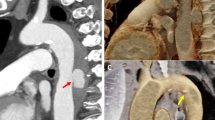Abstract
Lung torsion is the abnormal rotation of a lobe or lung around its bronchovascular pedicle. It most commonly occurs in the setting of pulmonary resection, though it has also been described after large-volume thoracentesis and video-assisted thoracic surgery, as well as spontaneously. Resulting ischemia can lead to infarction, making this an emergent diagnosis. As findings are often nonspecific, a high index of suspicion is required, especially in the postsurgical setting. 2D CT angiography findings are subtle and include direct signs of pedicle rotation on CT as well as indirect findings including loss of normal parenchymal enhancement, atelectasis of torsed lobe/lung, and abnormal fissure position. These direct and indirect findings are often appreciated on different window presets and upon review of images in multiple planes, with need to collate the information subsequently. 3D cinematic rendering (CR) using multi-planar light sources can readily highlight spatial relationships of vasculature in the chest and may be able to assist in the confident diagnosis of this sometimes subtle but life-threatening pathology. We have provided the first characterization of common lung torsion findings on 3D CR.





Similar content being viewed by others
References
Felson B (1987) Lung torsion: radiographic findings in nine cases. Radiology 162(3):631–638. https://doi.org/10.1148/radiology.162.3.3809475
Lubner MG, Simard ML, Peterson CM, Bhalla S, Pickhardt PJ, Menias CO (2013) Emergent and nonemergent nonbowel torsion: spectrum of imaging and clinical findings. RadioGraphics 33(1):155–173. https://doi.org/10.1148/rg.331125016
Dai J, Xie D, Wang H, He W, Zhou Y, Hernández-Arenas LA, Jiang G (2016) Predictors of survival in lung torsion: a systematic review and pooled analysis. J Thorac Cardiovasc Surg 152(3):737–745.e3. https://doi.org/10.1016/j.jtcvs.2016.03.077
Cable DG, Deschamps C, Allen MS, Miller DL, Nichols FC, Trastek VF, Pairolero PC (2001) Lobar torsion after pulmonary resection: presentation and outcome. J Thorac Cardiovasc Surg 122(6):1091–1093. https://doi.org/10.1067/mtc.2001.117839
Gilkeson RC, Lange P, Kirby TJ (2000) Lung torsion after lung transplantation. Am J Roentgenol 174(5):1341–1343. https://doi.org/10.2214/ajr.174.5.1741341
Irie M, Okumura N, Nakano J, Fujiwara A, Noguchi M, Kayawake H, Yamashina A, Matsuoka T, Kameyama K (2014) Spontaneous whole-lung torsion after massive pleural effusion and atelectasis. Ann Thorac Surg 97(1):329–332. https://doi.org/10.1016/j.athoracsur.2013.04.133
Duan L, Chen X, Jiang G (2011) Lobar torsion after video-assisted thoracoscopic lobectomy: 2 case reports. Thorac Cardiovasc Surg 60(02):167–169. https://doi.org/10.1055/s-0030-1271182
Apostolakis E, Koletsis EN, Panagopoulos N, Prokakis C, Dougenis D (2006) Fatal stroke after completion pneumonectomy for torsion of left upper lobe following left lower lobectomy. J Cardiothorac Surg 1(1). https://doi.org/10.1186/1749-8090-1-25
Dappa E, Higashigaito K, Fornaro J, Leschka S, Wildermuth S, Alkadhi H (2016) Cinematic rendering – an alternative to volume rendering for 3D computed tomography imaging. Insights into Imaging 7(6):849–856. https://doi.org/10.1007/s13244-016-0518-1
Fellner FA (2016) Introducing cinematic rendering: a novel technique for post-processing medical imaging data. J Biomed Sci Eng 09(03):170–175. https://doi.org/10.4236/jbise.2016.93013
Eid M, Cecco CND, Nance JW, Caruso D, Albrecht MH, Spandorfer AJ et al (2017) Cinematic rendering in CT: a novel, lifelike 3D visualization technique. Am J Roentgenol 209(2):370–379. https://doi.org/10.2214/ajr.17.17850
Hammer MM, Madan R (2017) Clinical and imaging features in lung torsion and description of a novel imaging sign. Emerg Radiol 25(2):121–127. https://doi.org/10.1007/s10140-017-1563-x
Kim EA, Lee KS, Shim YM, Kim J, Kim K, Kim TS, Yang PS (2002) Radiographic and CT findings in complications following pulmonary resection. RadioGraphics 22(1):67–86. https://doi.org/10.1148/radiographics.22.1.g02ja0367
Author information
Authors and Affiliations
Corresponding author
Ethics declarations
Conflict of interest
The authors declare that they have no conflict of interest.
Ethics statement
An appropriate institutional review board approved this study.
Additional information
Publisher’s note
Springer Nature remains neutral with regard to jurisdictional claims in published maps and institutional affiliations.
Rights and permissions
About this article
Cite this article
Jhala, K., Madan, R. & Hammer, M. A pictorial review of lung torsion using 3D CT cinematic rendering. Emerg Radiol 28, 171–176 (2021). https://doi.org/10.1007/s10140-020-01805-1
Received:
Accepted:
Published:
Issue Date:
DOI: https://doi.org/10.1007/s10140-020-01805-1




